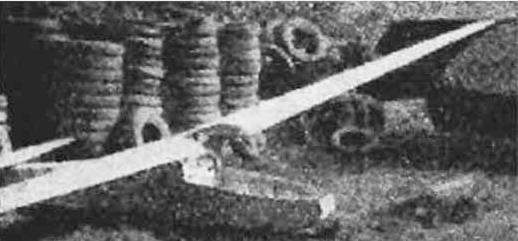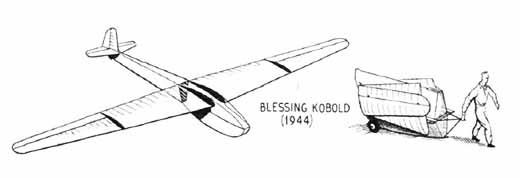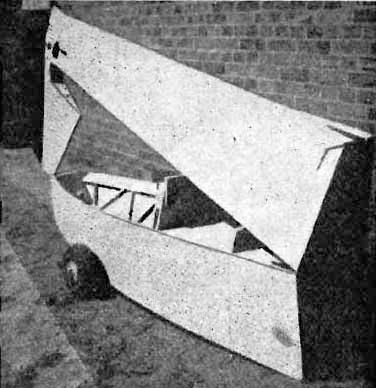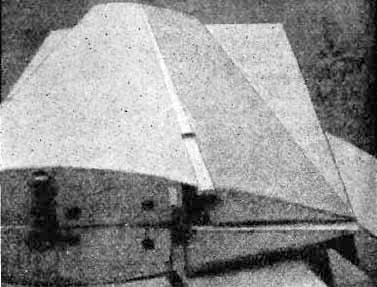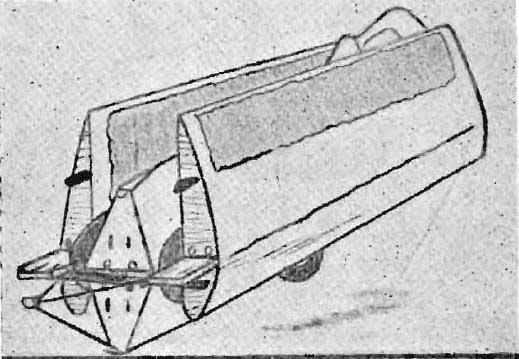THE "KOBOLD "
Constructed by G. BLESSING in 1944.
(compiled from Thermik, Jan.. 1950}.
True soaring usually begins where most pilots have to stop flying because the high performance sailplane, trailer. motor-car and driver necessary for cross-country soaring are too expensive. So long as a motor car and trailer are necessary there is little to choose between a miniature sailplane and a 17 m. span, both need expensive cars and trailers,
An entirely new approach is required, not necessarily theoretical but practical, to develop a sailplane as 'sports gear' which the pilot can transport, assemble and store as easily as a pair of skis, a foldboat or a camping tent. In 1944 G. Blessing constructed his "Kobold" on these principles. As no steel tubing was available. it was constructed in wood. Its performance approximated that of the "Rhön Bussard." On landing, after a cross·country, it could be dismantled by two men. The rear fnselage folded forwards over the front fuselage. The outer wing sections folded under the inner wing sections, and both folded along the fuselage .
The landing wheel was then displaced to the side of the fuselage and an additional landing wheel, carried in the locker, was placed on the other side of the fuselage to give a wheel track of 80 cm. A cover with inflatable sections is then drawn over the complete sailplane which protects it during transport. The pilot can then pull his sailplane by hand to the nearest railwaystation, or hire a bicycle or a motor bicycle to tow it home. Its dimensions when dismantled are: length 3 m., width 1.05 m., height 1.35 m., total weight 125 kg. Of this the ' transport' parts (spare wheel, cover. transport attachments weigh only 10 kg.).
It is thus possible to store it in any room, cellar or attic. It can be taken to the launching field by hand as it is nothing more than a two..wheeled wheelbarrow, or towed by a bicycle, or if it is very far away, a motor cycle can be hired to tow it.
It is ideal for private or group ownership. After all, soaring is above all an individual experience, private owners usually look after their own property more carefully than club members and it would be desirable to have more private owners in all clubs. Gliding clubs could well emulate motor cycle clubs in this respect where all members own their own machines.
When soaring in the '"Kobold" one is freed from the worries of organizing costly retrieves, when one lands, one can find one's way home with one's sailplane by utilizing public transport, if necessary. It would also free its owners from geographical bondage to fixed soaring sites and would allow them to prospect new soaring sites in hitherto unapproachable districts. For instance, it could be taken up in ski lifts and furniculars to explore new alpine sites.
Mr.. Blessing also built a small caravan into which the sailplane fitted. When the sailplane was taken out his family.could live in it and thus oould accompany him during his soaring week-ends. Blessing has also designed a further development of these ideas in which the pilot's cabin is turned into a motor scooter on which he can retrieve himself towing the rest of his fuselage and folded wings.
| Type |
Single seat glider |
| Dimensions |
Length 5,3 m , height , span 12,0 m , wing area 10,3 m2 , |
| Weights |
Empty 125 kg, loaded , max. take off we |
| Performance |
Max.. speed , cruising speed , range , endurance , service ceiling , climb |
| Type |
Werk.Nr |
Registration |
History |
|
|
|
|
